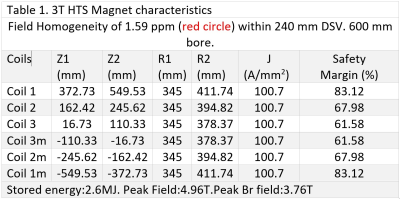4419
A 3T Head Scanner Designing Stage: the HTS magnet and the 200mT/m Hyper-Vision Gradient Coil.1MRI Devices, Kyoto Future Medical Instrument Inc., Kyoto, Japan, 2ARKFIELD PTY LTD, Brisbane, Australia, 3Research and Educational Unit of Leaders for Integrated Medical Systems, Kyoto University, Kyoto, Japan
Synopsis
This work presents the design stage of a 3T MRI head scanner aimed to register temporal physiological events in the scale below 1 sec while imaging brain structures below 0.5 mm of resolution. The hyper-vision gradient coil concept is capable to produce 200 mT/m and nearly 1900 T/m/s using a high end amplifier. The 3D folded coil exhibits shoulder cut of an aperture of 250 mm and a DSV of 250mmx210mm while keeping resistance, eddy currents, force and inductive decoupling with the HTS magnet under control. Details and characteristics of the coil and magnet are presented in this work.
Purpose
This work aims to introduce the design stage of a 3T MRI head scanner based on DI-BSCCO Type-HT wire and a high performance gradient coil capable to probe at mesoscopic scale the connection between micro-vessels and brain tissue while measuring temporal physiological events in the scale below 1 sec.
Introduction
The causes of neurodegenerative diseases such as Alzheimer, Parkinson and dementia reminds unknown due to the lack of imaging tools capable to probe the interaction mechanism and interface of micro vessels with the brain tissue at the mesoscopic scale (<0.5mm). How at this scale, neurons with similar functions clusters, storages information, forms dynamic micro-circuits and interacts with the brain tissue remains an unexplored area or terra incognita1. Current gradient coils performance limits the frontier of understanding of such mechanism mainly due to the lack of spatiotemporal resolution to probe physiological events in the scale below 1 sec and registering anatomical imaging with a resolution below 0.5mm. The connectome whole body gradient coil boosts 300 mT/m with high risk of PNS if the coil is used at full performance2. In this work an alternative head symmetric gradient coil is architected to produce 200 mT/m and nearly 1900 T/m/s to delve at the scale below 0.5mm. A high end amplifier 850A and 2000V will be use to drive the hyper-vision coil.Method
A first version of an unshielded 3T HTS magnet was designed. A pk-pk homogeneity smaller than 5 ppm was targeted in a 240 mm DSV. The characteristics of the DI-BSCCO Type-HT wire was provided by Sumitomo Electric Industries, Ltd. The number of axial turns in each coil were constrained to be even, the peak field and the Br field component were constrained; safety margin, axial force, simplified hoop stress, sensitivity of the solution and computing precision were also controlled to guarantee a reliable and practical to manufacturer design. The stability of the solution was tested by perturbing each coil within an error tolerance range (±0.5mm) and a minimal number of passive shim pockets were determined in order successfully correct unwanted field inhomogeneity while minimizing the risk of Bo drift due to shim heating. Two Hyper-Vision gradient coils were designed using different ID envelopes; two DSV sizes were also defined and a maximum non-linearity of 6.5% was specified. The secondary field was controlled in the DSV and constrained to be as linear as the primary field and the maximum residual value was set to <0.5%, considering an aluminum cryostat. The shoulder cut aperture was fixed to 250mm. Coils and shims are inductively decoupled with the magnet and a power loss <0.5 watts was constrained in the cold surface. Peak values of current densities were avoided in the coil and in the cryostat(induced); same as peak values of force. The wire length was minimized by using l1 (Z-gradient coil) and l2 (X, Y-gradient coil) norms optimization3.Results and Discussion
Fig 1 a, shows the magnet and the field homogeneity profile. The Br component is higher at the extreme axial planes of the coil 1(1m) thus increasing the safety margin up to 83%. Replacing some axial turns with a wire of higher critical current reduces the safety margin below 60%. Table 1, describes some characteristics of the HTS magnet. Figs b, c and d describe the result of the stability analysis and the prediction of 24 passive shims azimuthal drawers to be used to bring within 5 ppm the resultant homogeneity after construction. Fig 2 a, shows the envelope of the hyper-vision coil. The coil envelop total length is 700mm and distance shoulder to DSV center is 150 mm. Fig 2 b,c and d describe the gradient coil set. Table 2, presents the main characteristics. The Z-coil with ID 400mmID produces 200 mT/m; which is predominantly used in fMRI. The shoulder cut may shift up the cylinder eigenmodes thus avoiding mechanical resonances. Reducing the coil radius limits the surface area and the space to place conductors. A brief E-field calculation (5mm Duke model) foresees that at the top of the scalp and neck area are where major density of the E-field and current density are registered.Conclusion
The designing stage of a head scanner based on a 3T HTS magnet has been presented. The hyper-vision gradient coil producing 200 mT/m and nearly 1900 T/m/s to delve at the mesoscopic scale the connection between micro-vessels and brain tissue has been introduced. The two hyper-vision coil envelopes with standard ergonomics dimensions classifies as “connectome” gradient coils and would be the necessary boosting to bring UHF to clinical practice at its full potentiality.Acknowledgements
No acknowledgement found.References
1- Le Bihan, D., & Schild, T. (2017). Human brain MRI at 500 MHz, scientific perspectives and technological challenges. Superconductor Science and Technology, 30(3), 033003.
2- Winkler SA, Schmitt F, Landes H, DeBever J, Wade T, Alejski A, Rutt BK. 2016 Gradient and Shim Technologies for Ultra High Field MRI. NeuroImage.
3-Sanchez-Lopez H. 2016 The forgotten planar gradient coil. 24th Annual Meeting of the International Society for Magnetic Resonance in Medicine (ISMRM).
Figures


